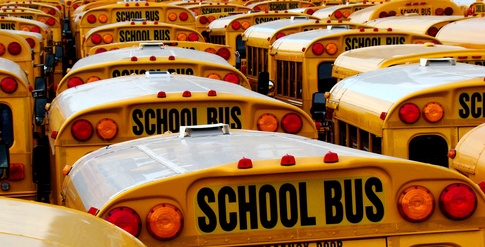
School buses and school bus drivers provide an essential service in transporting children to and from school each day. However, with the important obligations of transporting children comes the responsibility to also build buses that are safe and reliable, while only hiring bus drivers who are highly qualified to competently drive them. The School Bus Information Clearinghouse (SBIC) collects and provides informative facts pertaining to the United States school bus transportation system.
School buses drive children to and from school almost every day and in almost every community. According to the SBIC, every school day, approximately 450,000 school buses transport over 24 million children to and from schools and other school-related activities. Furthermore, each year 8.8 billion student "to-and-from-school" trips are made by buses in the U.S., with an additional 1.2 billion trips being made for field trips.
Despite the large number of children commuting in school buses and the remarkable number of trips the school buses make each day, school buses are the safest method of travel for children going to and from school. Fatal crashes involving school bus passengers are very rare; in 2010, only five children were killed as passengers on school buses, and because each fatality occurred in a separate state, 45 states had no fatal accidents involving school bus occupants. Also, between 1990 and 2000, an average of just six children died every year while riding school buses. A study conducted by the Transportation Research Board of the National Academy of Sciences found that every year more than 800 school children are killed during regular school transportation hours as occupants in other types of vehicles, as pedestrians or as bicyclists.
One of the reasons school buses are such a safe form of transportation is that school buses are required to conform to higher construction standards and must possess a higher quality of equipment than most other vehicles on the road. To ensure safety, each school bus is equipped with well-padded, high-back seats, superior brake systems that allow buses to stop within shorter distances than other large vehicles, and rollover-protection devices that decrease the chances of a roof collapsing. Other additional parts that enhance the safety of school buses include warning signs to indicate when passengers are loading or unloading, swing-out stop arms, additional mirrors, fuel system protectors and emergency exits.
School bus drivers are required to meet higher qualification and testing standards than other drivers, and thus the competent and skillful driving by highly trained bus drivers is another reason for the low crash rate and successful safety records of school buses. All drivers must receive a Commercial Drivers License (CDL), must take and pass extensive state training programs regarding school buses, and must also pass drug and alcohol screenings and background checks.
Due to the discoveries pertaining to environmental hazards and technological advancements that serve to prevent such hazards, many school buses being made today are constructed and operated so as not to pollute the environment. To protect the children and the environment from pollution, most school buses are currently being built (as of 2011) with environmentally advanced "green" diesel engines or natural gas engines.